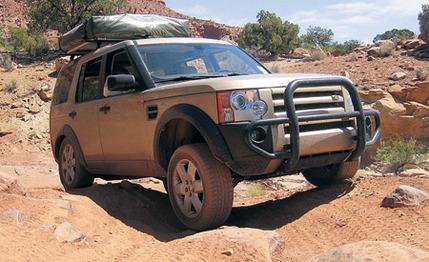 Long-Term Road Test
Long-Term Road Test
Mapping the Serengeti or mooring at the mall? Roaming Waziristan or waiting at the school-bus stand? What is a Land Rover's true métier - that French word means the work one is particularly suited for - now that the Ford-owned company has fully transcended its birthplace in the Yorkshire mud to become an urban fashion accessory?
As always, the measure of the métier is made from behind the wheel. Never ones to flee from a beckoning leather seat, we rolled up 40,000 miles in a 2005 Land Rover LR3 to find out. This is Rover, Round 2. In 1996, we performed the same public service by diving deep into one of the LR3's predecessors, a $38,730 Land Rover Discovery [C/D, May 1996]. We discovered that the Disco's métier was as a sturdy expedition taker, comfortable and spacious and beset with strange ergonomics and British quality stereotypes.
Little has changed in 10 years.
To avoid biasing our métier meter, we again went for full everything on our long-term Landie: full opulence with the top-trim HSE model, full 300-horse V-8 power, and some extra off-road kit [see Baubles and Bolt-Ons]. The 5779-pound pride of Her Majesty's Fleet lumbered up to Hogback headquarters in June 2005 wearing a window sticker of $53,870, including $49,995 for the HSE (the HSE gets a navigation system, 19-inch wheels, blue-blazing bixenon headlamps, rain-sensing wipers, and park-distance control among the additional comfort features added to the $44,995 SE).
Our options were a $1250 rear-seat package that included a third row and related amenities such as extended curtain airbags; a $1050 Cold Climate package that included heated front seats and an electrically heated windshield; rear-seat climate control for $950; towing equipment for $375; and a center-console drink chiller for $250.
The first safari was to the track, where 60 mph loafed by in 8.6 seconds, a time that would inexplicably bulge to 8.8 seconds once the 32-valve DOHC 4.4-liter V-8 had racked up 40,000 miles. Conversely, the initial skidpad performance of 0.69 g and the stopping distance of 175 feet changed hardly at all.
Learning the LR3's many controls, we were skillful button pushers by the time of our first service at 7500 miles (which was free, owing to Land Rover's policy of offering maintenance on the company's tab up to 45,000 miles). Early logbook entries noted a quiet highway ride and stout passing power even with a race-car trailer hooked up.
The V-8 was always thirsty. Over 13 months, we made 173 visits to Exxonistan to fill the 22.8-gallon tank with increasingly pricey premium, averaging 15 mpg. That's just 1 mpg better than our '96 Disco, despite a new overhead-cam engine and six-speed automatic. The farthest we ever trekked on a full tank: 390 miles, averaging 18.1 mpg. More often, the fuel light was shining significantly earlier - over the test, we averaged 232 miles between fill-ups - leading to this frustrated Yoda-like logbook entry: "250 miles on a tank do not an adventure vehicle make!"
A few quality ticks showed up early, some cured at routine service stops, others with three unscheduled dealer visits. At 5613 miles the fuel door suddenly refused to latch, and a fix was performed gratis under the four-year/50,000-mile warranty. At 9633 miles, the dealer replaced under warranty some black exterior door-trim panels that had faded to a foggy gray. At 13,301 miles, the LR3 became convinced it was capsizing, flashing a panicky "overturn" warning light even in low-speed turns. At the same time, the air suspension refused to rise to its maximum setting. The dealer diagnosed a short in the suspension height switch and replaced it - all bills absorbed by the Mother Protector warranty.
By 22,817 miles, the LR3 was losing its new-car luster. A low-coolant warning light was twinkling, an unsightly crack cleaved the windshield, and it was being summoned back to the barn for a fuel-tank recall (sadly, not to make it bigger, but to replace it to avoid a potential leak into the breather pipe that could pump fumes into the cockpit). The coolant warning was caused by a shorted sensor in the radiator's expansion tank and was replaced under warranty. The new electrically heated windshield set us back $1031, which we didn't register as a repair because the crack was probably caused by an errant stone. Soon after, the new windshield's new weather strip flapped loose and had to be reglued.